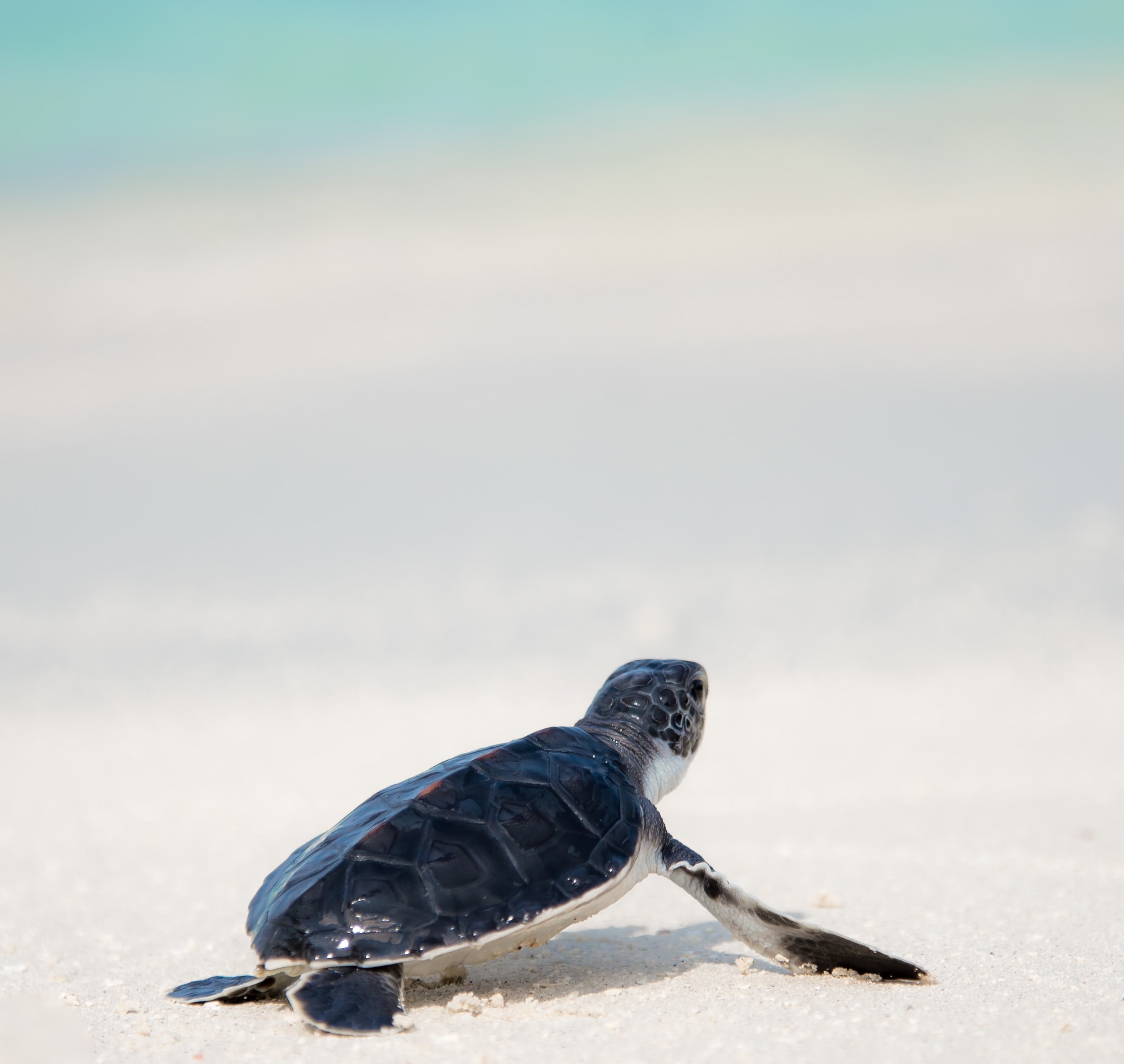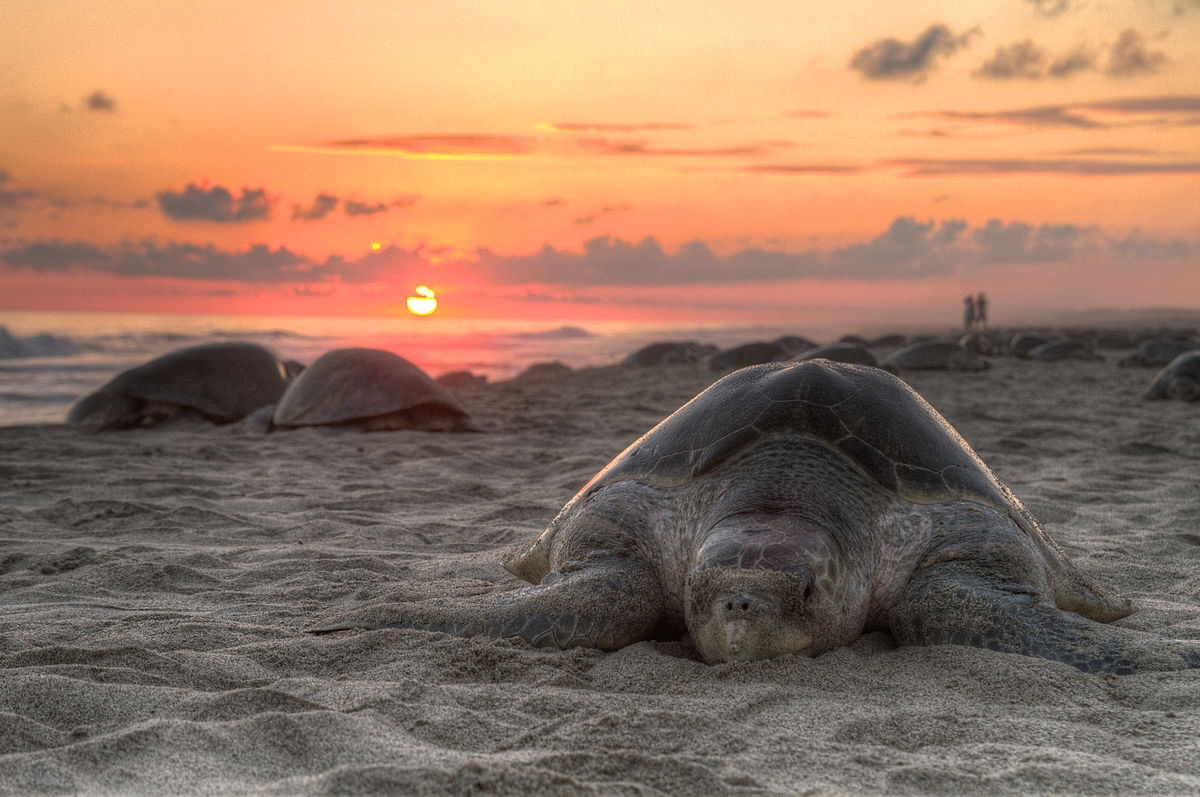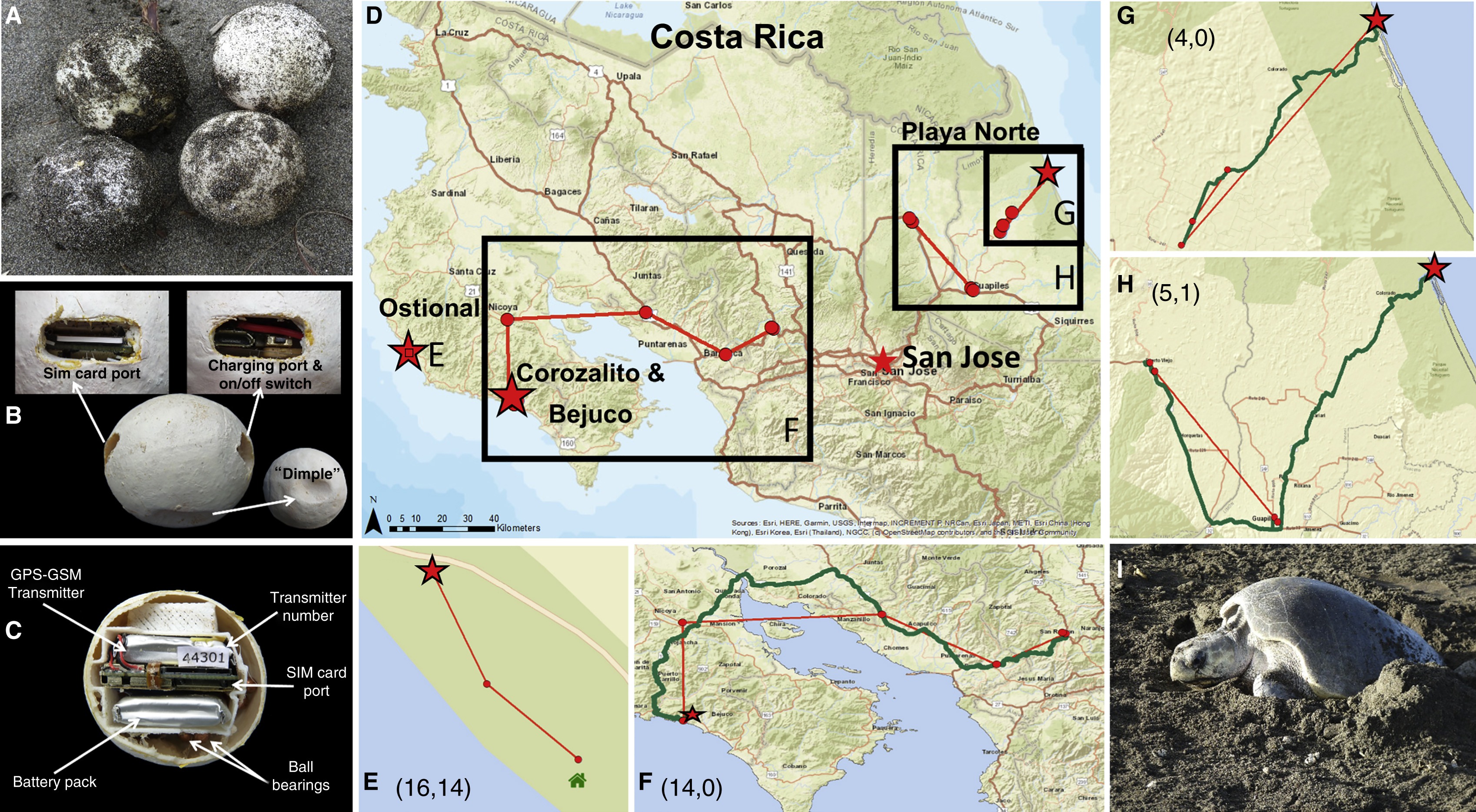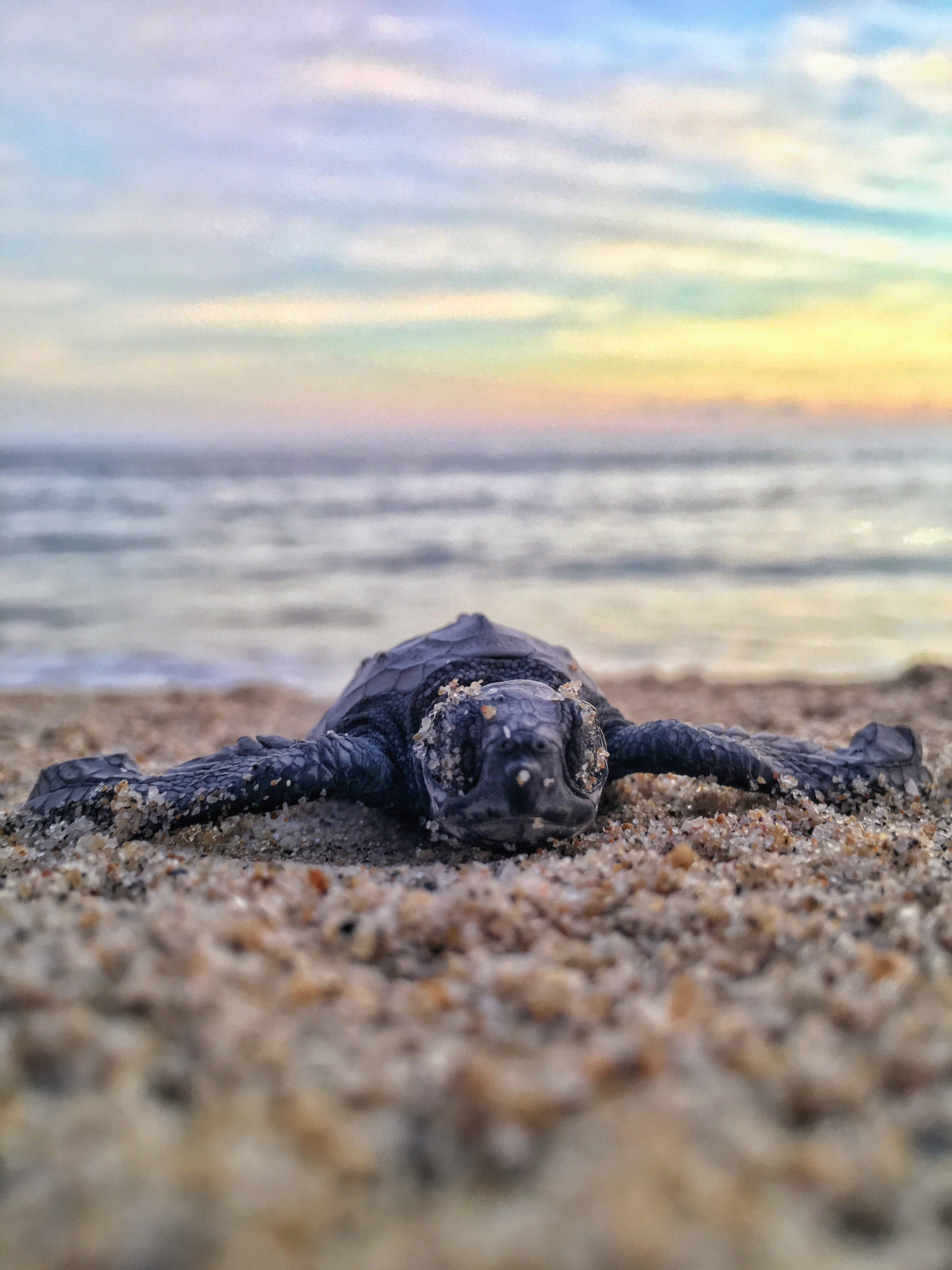
Sea turtle hatchling. Photo by jcob nasyr on Unsplash.
Pheasey, H., Roberts, D. L., Rojas-Cañizales, D., Mejías-Balsalobre, C., Griffiths, R. A., Williams-Guillen, K. 2020. Using GPS-enabled decoy turtle eggs to track illegal trade. Current Biology 30:19. R1066-R1068. https://doi.org/10.1016/j.cub.2020.08.065.
Sea turtles
Sea turtles are ocean-dwelling reptiles that live in all the world’s oceans except for polar regions. Sea turtles spend the majority of their lives at sea, travel long distances, and can grow very large. The largest of all is the leatherback sea turtle, known to grow up to 3 meters long and weigh 1500 pounds (the weight of a small car).
There are 7 living species of sea turtles, all* of which are threatened according to the
International Union for Conservation of Nature’s (IUCN) Red List :
*Except for flatback sea turtles which are data deficient
- Green sea turtle (Endangered)
- Loggerhead sea turtle (Vulnerable)
- Kemp’s Ridley sea turtle (Critically Endangered)
- Olive Ridley sea turtle (Vulnerable)
- Hawksbill sea turtle (Critically Endangered)
- Flatback sea turtle (Data deficient)
- Leatherback sea turtle (Vulnerable)
Female sea turtles come to shore, typically at night, to lay their eggs. Using their hind flippers, they dig a 40-50 cm deep hole. The hole is then filled with 50-350 soft-shelled eggs. After egg-laying is complete, the turtle re-fills the nest and smooths the surface. Sometimes they will even dig decoy nests and attempt to camouflage true nests with twigs.

Olive Ridley sea turtle arriving ashore to nest. This Photo by Unknown Author is licensed under CC BY-SA-NC.
Turtle-y Awesome Facts
Sea turtle scientists are called testudinologists
Sea turtles can’t retract into their shell for protection
A group of Ridley sea turtles nesting is called an arribada
Sea turtles have temperature-dependent sex determination
Shell-fish Humans

Sea turtle eggs.
Although it is illegal to harvest and sell sea turtle eggs in many regions, there is rarely enough resources to enforce these laws. Illegal wildlife trade is valued at 20-30 billion dollars per year. On a scale of illegal economic activities, wildlife trade ranks fourth behind drugs, counterfeiting, and human traffic
king. The capture and trade of wildlife poses many threats to wildlife and the ecosystem. Besides the direct risk to the individuals captured, poaching can also cause population collapse, introduction of non-native species, habitat degradation, and changes to the food web.
Sea turtle eggs are commonly sold to restaurants to be prepared as delicacies. Some consider them to be aphrodisiacs, though there is no evidence to support this. There is, however, evidence to suggest that sea turtle eggs can be unsafe for human consumption due to their heavy metal load. Other reasons for egg collection include protein source, medicinal use, and shell use for arts and crafts.
An Egg-squisite Idea

Paso Pacifico investeggator logo
Paso Pacifico, a nonprofit organization, had a vision to protect
sea turtles and brought it to life!
- Kim Williams-Guillen was inspired by Breaking Bad
- In the show, DEA use a GPS tracker to follow drug dealers
- Paso Pacifico wins $10,000 in the Wildlife Crime Tech Challenge (2016)
- Paso Pacifico wins $100,000 to accelerate product development (2017)
- Paso Pacifico teams up with Hollywood prop stylist Lauren Wilde
- InvestEGGator, the robo-egg, is born
InvestEGGator is a 3D-printed turtle egg look-alike. Inside the egg there is a GPS–GSM transmitter. The transmitters remain dormant until they are exposed to open skies, at which point they are paired to a GPS signal within 30 seconds and give location accuracies of 10-15 meters. For greatest resemblance to true eggs, the structures are soft, include a ‘dimple’, have a waxy finish, and are filled with silicone rubber for weight and flexibility.

A. 3 real, one decoy (bottom left). B. External ports. C. Internal workings. D-H. Data provided by loggers. Stars are deployment sites. Green is the likely ‘true track’. I. Olive Ridley sea turtle nesting. Pheasey, H. et al., 2020.
In this study the authors deployed 101 decoy eggs on four different beaches in Costa Rica. The decoys were set to emit a signal once per hour. The eggs were adjusted to closely resemble the 3 different sea turtle species: Green [43], Loggerhead [1], and Olive Ridley [57]). During or directly after the true eggs were laid, the robo-eggs were positioned in the center of the nest. Nests were checked every day for signs of illegal extraction (footprints, holes, or empty chambers).
Eggs-periment Results

44 decoys deployed on the Caribbean coast and the malfunction rates of these transmitters. Pheasey, H. et al., 2020.
Unfortunately, the robo-egg failure rate was rather high, at 32%. This is thought to be due to moisture leaking through the seals. A further limitation of the study was the low signal reception on the Caribbean coast.
Despite these difficulties, the study had some egg-cellant success!
- 25% of the robo-eggs were illegally taken
- Tracked eggs from 5 clutches
- Uncovered 5 trafficking routes
- The longest – a full trade chain 137 km long
- Found 2 properties of interest to law enforcement
Hatching success per clutch varied from 0-100%. The median success level in clutches with robo-eggs was 87%, in the control group the median was 94%. The authors concluded that the decoys had no significant effect on hatching success (of real eggs). This study shows how useful GPS-GSM systems can be in science, particularly to reduce illegal wildlife trade in a non-invasive way.
Shell-ebrate Good Times!
Due to the extensive decline in human movement and tourism in 2020, several regions are seeing record numbers of sea turtle hatchlings!
How can you Shellp?

Sea turtle. Image by Mitchel lensink on unsplash.
- Report Poaching globally @ https://wildleaks.org/
- Ask before you buy (If unsure of material or origin)
- Use only certified products
- Like FSC replenished paper products
- And Ocean Wise sustainable seafood
- Research before you buy pets
- Make a pledge
Sea More
https://www.facebook.com/watch/?v=777970039011172
https://www.wwf-congobasin.org/stop_illegal_wildlife_trade.cfm
I am a 2nd year Master’s student at the Memorial University of Newfoundland. I am researching the highly invasive species the European green crab, and the impact extreme weather events has on its population abundance and distribution.